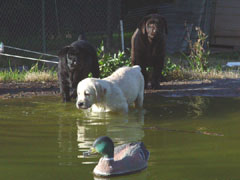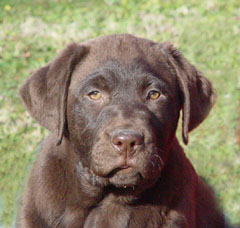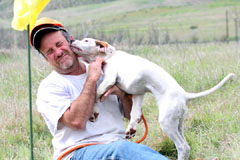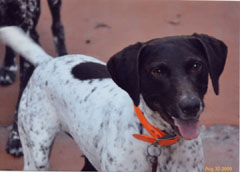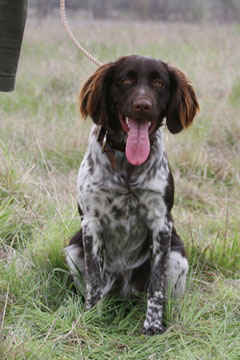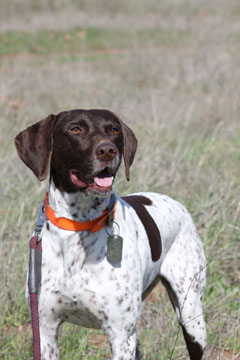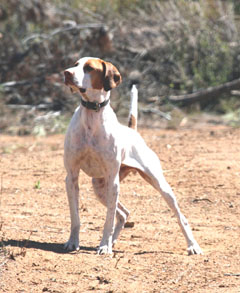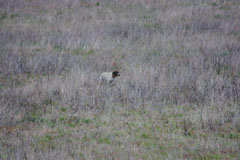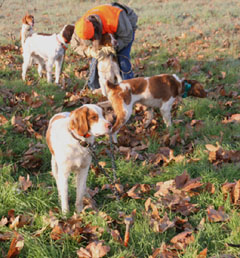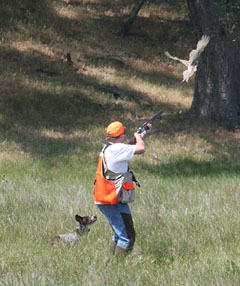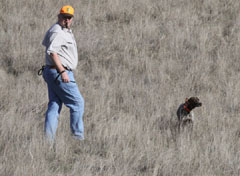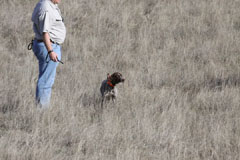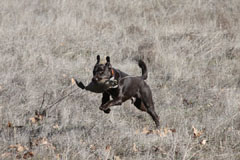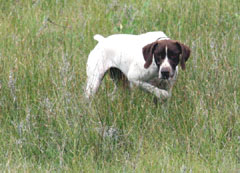|

So you want to photograph your dog?
Dogs, by their very nature, become part of the family of which they are a member. Just like our other family members, we like to document their participation in our lives and what they look like by taking photographs of them to put in the family album, carry in our wallet, or place on the wall. The question then becomes, how can you get a good picture of your dog?
The first thing to address is what kind of camera(s) do you have? Since most everyone has gone to digital cameras rather than film, I am going to assume that you are using a digital camera. You may have one on your mobile phone, and you probably have one or two in the house. With increasing technological advances, they will all take decent to excellent pictures with some limitations based on the camera.
Cameras
Phone cameras have an extreme wide angle lens so that they can take close-ups, or group shots from a few steps away, but are not good for long-range photography. However, they are often handy for that spontaneous image that just happens to come along when you are out with your dog. Settings and focus are automatic so you just shoot and hope for the best. Sometimes it can be surprising what you come up with when you take such shots.
|
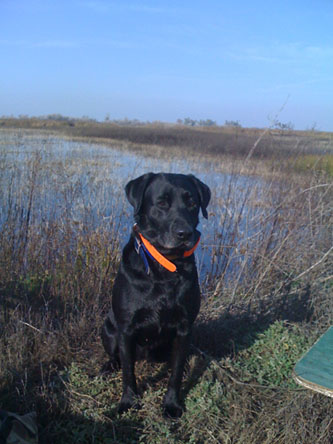
|
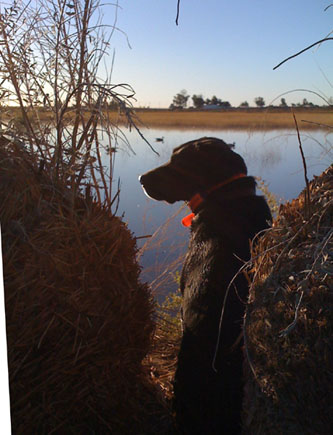
|
Both of these shots were taken with a phone camera while out hunting and capture the feel of a day in the duck marsh with my dog. So don't be afraid to snap off a few frames if you get the chance, you may be pleased with the result.
Point and Shoot cameras come in a wide variety of styles and functions, not to mention sizes. You can get cameras smaller than a pack of gum to some that are just slightly larger than hand size. Some are designed to be dustproof and either water "resistant" or even waterproof. If you are looking for something to take into the field in your hunting kit, give these a look. Most have only nominal settings for close-up, portrait, landscape, and action shots with automatic focusing. Some have a zoom function and if you are buying one, I recommend getting something with a 10x-12x optical zoom capability. Although the smaller the camera, the easier it is to slip it into your pocket or hunting pack and carry around, the smaller the camera the more difficult it is to hold it steady while taking pictures. If it's so small that you are holding it with the tips of your fingers, then you will have difficulty not moving the camera when you snap the shutter. Something that is hand sized or even just slightly larger is a bit easier to hold steady. There are a wide range of prices for these cameras but due to their popularity they are reasonably affordable. Cameras from Canon, Nikon, Olympus, Pentax are all good quality and many other manufacturers also produce good equipment. These cameras are handy because they are easy to toss into the car or pack on trips, they are inexpensive, and they are easy to use. However, they are limited in their ability to take quality photos from too great a distance and their shutter speeds are often a bit slow for taking action shots. They are great for snapshots around the house, while training, and for posed shots.
Digital single lens reflex (DSLR) cameras are essentially the replacement for the old 35mm film cameras that many of us grew up with. Most of them come with the capability to exchange lenses so that you can use wide angle, telephoto, or zoom lenses with them. If you have a 35mm camera and lenses it is quite possible that a DSLR camera from the same manufacturer will be able to use those lenses. Something to consider if you haven't yet switched over to digital but still have your old 35mm camera gear. Canon and Nikon lead the field in quality DSLR equipment, as they did in film cameras. Both companies have DSLR's from entry level quality ranging up to professional grades. The prices for these cameras are greater than the point and shoot cameras, although some entry level cameras are down near the upper end of the point and shoots. The advantage of the DSLR is the ability to use a wide range of lenses depending on the shooting situation, and to either use automatic settings or adjust them depending on your needs and also skill level. If you take lots of pictures, can afford a bit more than a point and shoot camera, and want the additional quality that these cameras provide, they are well worth the investment and will last a lifetime if properly cared for and maintained.
Taking Photos
Since I work with photos when creating my paintings of people's pets I often get less than ideal material sent to me that I am supposed to work with to create a masterpiece. I have therefore come up with some basic instructions for folks to take posed pictures of their animals. In this case, I'll just deal with dog photos.
Rule #1. Take the dog outside in the sunlight, or at least natural light so that it shows the contours and musculature of the dogs body. I prefer late morning or late afternoon sunlight so that the shadows aren't too strong and there is plenty of light to show detail. If the sun is low in the sky (early morning or evening) the shadows are longer and stronger and although a high-contrast shot can be interesting, you often lose detail in the dog. Have the sun at your back.
Rule #2. Turn off the flash. I would make this rule number 1, but if you take the dog outside you seldom have issues with the camera thinking you should use the flash. Flash photos wash out the eyes of the dog (red eye), which is the portal to the soul of the animal so that you may see all the dog but it is a soulless picture, and may make you think you took pictures of a demon with the redness where the eyes should be. The flash also washes out light on the dog's body and hence eliminates some of the countour of the dog, which I don't like.
Rule #3. FOCUS! I hate blurry pictures. If you are using the camera's autofocusing function, make sure that the spot selected for the focus point is on the dog, not the foreground or background. If you are manually focusing the camera, focus on the dog's eyes.
Rule #4. Get the dog to smile. We like people in photos to look happy, interested, excited or show some emotion when we take their photograph. The old "say cheese" can sometimes work. Dogs are no different. The better photo is of a dog that is alert, perked up, interested. All of our dog's have that "look" that we come to recognize as their personality. If you can capture that, you have a great shot. In sporting dogs, that can be the intensity when they are on bird scent, or the alertness when looking for birds, or waiting to be sent for the retrieve. Use a friend and have them hold a bird, bird wing, dummy, toy, or other object of interest while you take the pictures of the dog. Plant something in the yard (in a sunny spot) and have said friend work the dog over to that area while you snap off pictures. Engage the dog, then take the picture. Use food if your dog is food oriented. A dog with a glint in his eye and ears perked up with some tension in his body is generally better than one bored and looking for a place to lie down. However, if your dog's "look" to you is bored or carefree and easy-going, take that picture. No one ever got a picture of your old aunt Emma smiling either.
Rule #5. Get down on the dog's level when you take the picture. Kneel down, sit on the ground, or whatever it takes. Someone can help you up afterward. A picture of the dog taken while he is sitting at your feet and you are looking down on him shows the top of his head and back, but is not very natural looking. If your dog is a dachshund, I'm sorry. Set it on a table or chair. Same goes for the other small dogs unless you like lying down on the floor or ground. Unless the dog is some distance away you need to get low.
Rule #6. Try and pick a neutral colored background when possible. At the very least, something that is similar in tone to your dog's color. Darkish colored dog requires a medium to medium-dark background while a light colored dog requires a light to light-medium colored background. Most cameras have a light meter that tries to compensate for the overall light in the picture. If you have a dark dog like a black or chocolate lab, or liver pointer, and the background is a white fence, the camera will balance the light between the two. Hence, the dogs will be too dark to see detail and the fence will be slightly washed out. If the fence is tan or natural wood, the light balance would be much nicer. Similarly, photographing a black and light-yellow labrador together results in the black dog being too dark and/or the yellow being too light but you can seldom get both to look good without some after-image modification on the computer. The other option is to get close enough to the dog so that there is little, if any, background shown so that the exposure is all set on the dog.
Rule #7. Take lots of pictures. It's digital, if you don't like it, you can delete it later. You no longer have to pay for dozens of shots that aren't what you want. You can scroll through the pictures later, either on your camera or computer, and select only those shots you like to print and delete the rest. If you are taking action shots and are using a DSLR camera, set the camera to auto-drive and during action sequences, just hold the button down. You'll get 8-15 shots/sec and have a whole series to choose from when selecting that special shot.
Finer Points
The above covers most of what you need to think about when using a phone camera or point and shoot camera. If you have a DSLR camera, it opens up a wider range of options that you can explore. Below is only a brief summary. If you really want to get good, buy a book on taking digital photos and study it.
Lenses range from wide angle to telephoto. Zoom lenses often cover both extremes, for instance 18mm (wide angle) to 135mm (2.5X magnification). Many DSLR cameras, my Canons for instance, have an internal multiplying function that changes this. In my D30 and D50 Canon cameras that is 1.6, so that 18-135mm zoom lens actually is shooting at 29-216mm, which is slightly less of a wide angle to about 4X magnification. Personally, I like zoom lenses for shooting photos of dogs. It allows you to stay in one spot and take full-body shots to close-ups or when in the field, shoot the whole field to just the dog and immediate area he is working. If you've got the big bucks, you can opt for an internally stabilized lens system that actually has a gyroscopic feature that eliminates much of the shake and hand movement when taking a picture and gives you a sharper image. Or, use a hand grip, shoulder gun mount, or monopod, bipod or tripod to stabilize the camera. But whatever you do, buy the best lenses that you can afford as cost is pretty much directly related to lens quality and it shows in the quality of your pictures, primarily sharpness. If you are going to be taking a lot of pictures in the field, I suggest getting a large telephoto zoom, either something like a 75-200mm, or a 100-400mm lens that will reach way out there and catch the action.
Although a DSLR has the same standardized settings for taking pictures that you will find on the point and shoot cameras, being portrait, scenery, flowers or snapshots, and action plus possibly a couple for darkness, it also allows you to pick multiple settings as well as setting some other functions that affect your pictures. You may choose to set the shutter speed and let the camera adjust for the f-stop, you can set the f-stop and the camera will adjust for the shutter speed, or you can select both the shutter speed and f-stop yourself. Tied to this is your selection of the ISO, what used to be termed "film speed". The higher the ISO, the faster the "film speed" but the lower the quality of the image. The image develops some snow or graininess at the higher ISO settings. However, if you are trying to stop fast action such as a flying pheasant or running dog and you don't have a nice sunny day but it is early, overcast or near dark, you can up the ISO setting to over 1000 and still get a reasonable picture shot at greater than the 1/500th of a second needed to stop the action. At one time I even shot pictures of a moose cow and calf when it was so dark I could barely make them out by naked eye but by setting my ISO to 2000 and slowing the shutter speed to 1/60th of a second (they weren't moving) I got pictures that looked like they were taken in the light of mid-day. Personally, when shooting dogs in the field, I like to set my shutter speed at 1/1000th of a second and adjust my ISO so that my f-stop is between f11-f16 to give me a greater depth of field in the picture.
This brings up one other point to cover. When shooting portraits of your dog, or shots in the field, the depth of field (amount of foreground-subject-background) that will be in focus is related to your f-stop. The higher the f-stop number, the greater the depth of field and vice-versa. If you would like a portrait with a soft out-of-focus background behind your subject, use an f-stop as low as your lens will handle, whether that is 2.8, or 4 or 5.6 and then focus on the dog's eyes. The area behind the dog, if it is some distance away, will be softly out of focus.
Start early, they grow up fast.
Candid shots can be fun, and rewarding. They can also tell a story, or you can make one up.
Looking down on the dog, or from eye level? Which do you prefer?
|
Behind, |
In front of, |
Or to the side? |
DSLR telephoto, Hold the button down and keep shooting.
Point and shoot......................or, DSLR and telephoto zoom lens.
Adding people provides some interest as well. Of course, you don't get to shoot.
Sometimes you get lucky, and then sometimes, you cut off their head (oops).
|
Is he excited? |
Intent? |
Focused (sun at wrong angle and shot from behind the subject. It would have been better if they were turned around) |
Hopefully this information will help you to take good, or better, pictures of your dog. And maybe of the kids/grandkids too. If you are a member of the SDSDC then you have the option of bringing your photo problems to the attention of myself, Ron Dotson, or Randy Domingos and we will be happy to try and help you iron them out. In the meantime, good shooting, whatever your weapon of choice and breed of dog.
Ron Dotson.
For a
printable PDF version of Ron's tips Click here.
© 2010 San
Diego Sporting Dog Club, Inc. All Rights Reserved.
|
|




